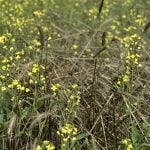It’s a question many both inside and outside of agriculture are asking — why are so many honeybees dying?
While some culprits have been fingered, experts say it’s not a problem that can be solved with a silver bullet.
“It’s very tempting to come up with easy answers, and if anything is clear, it’s that this problem is complex. So its solution is going to be complex too,” said Dennis vanEngelsdorp, an American apiarist and bee researcher.
Bee losses, winter mortality, spring dwindle, colony collapse — whatever people call it, it’s clear more honeybees are dying prematurely than in the past and not just in North America. Speaking at the annual Manitoba Beekeeper’s convention in Winnipeg, vanEngelsdorp said at least 50 countries have tracked increased bee mortality in recent years.
Winter loss has been tracked in U.S. bee colonies for the last eight years, revealing average mortality of about 30 per cent. The majority of apiarists polled found losses of only half that to be acceptable.

“And that’s still an astonishingly high number, can you imagine a corn grower losing 15 per cent of his crop every year, and going, ‘oh yeah, that’s just normal.’ That’s a very high level of loss, let alone the fact that we have double that loss in the U.S. every winter,” vanEngelsdorp said. “Back in the day people were embarrassed if they lost 10 per cent of their colonies over the winter, they were mortified, they wouldn’t tell their neighbours.”
Manitoba’s provincial apiarist Rhéal Lafrenière, noted that Manitoba’s losses last winter were even higher at 46 per cent, while the average loss in Ontario was 58 per cent.
“We consider our 46 per cent well outside of normal, but if we would have had some of the same environmental contaminants and influences that Ontario had, our 46 per cent could have turned into 56 per cent; it could have turned into 66 per cent,” Lafrenière said.
No conclusive link
A changing climate and harsh winters have played a role, he said, but he stressed that there is a complex matrix of issues contributing to decreased pollinator resilience.
One is pesticides, but neonicotinoids receive the most attention.
Last year, Ontario beekeepers launched a class-action suit against Bayer and Syngenta for what they claim was the negligent design and distribution of neonicotinoid products.
And while bees have undoubtably died after exposure to the pesticide, which is often used as a seed coating on corn and soybeans, vanEngelsdorp said its effect is not entirely understood.
“There is yet to be shown conclusive colony-level data that shows colony-level negative effects from field realistic neonic exposure,” he said. “Part of the reason is that very little of this stuff actually gets into the nectar and pollen.”
Read Also

Cereal cover crops show mixed flea beetle protection for canola
University of Manitoba researchers are testing if planting fall rye and oat nurse crops help growers reduce damage without hurting yield.
However, he added that there is a legitimate argument that no pesticides should be making their way into nectar or pollen.
“This may be affecting native bees and bumblebees very dramatically, but we haven’t seen negative effects at the colony level, outside of those dust clouds,” vanEngelsdorp said.
Manitoba beekeepers hold a variety of opinions on the use of neonicotinoids, but Lafrenière said there are positive discussions via the National Pollinator Working Group.
“I think that’s bringing the right people to the table,” he said, adding that the intense focus on this one pesticide has been frustrating at times.
“I don’t want to downplay what happened four, five years ago… there was this major loss and we didn’t know what it was and we were scrambling… the neonic use was just going up, and it was kind of a natural thing that we needed to look at,” Lafrenière said.
Health Canada’s Pest Management Regulatory Agency has monitored bee deaths linked to neonicotinoids in recent years. Most were in Ontario. The PMRA said 63 beekeepers reported losses due to neonics at 330 bee yards in 2014. That’s a decrease from 2013, but still higher than 2012 when only 43 beekeepers reported neonic losses.
“We’ve seen most of these reports coming out of the corn-growing areas in Canada, primarily Ontario, but we’re seeing some in Manitoba as well as Quebec, and we have linked that exposure to neonic in the corn seed treatment, corn and soybeans,” said Marcie Smerchanski, a regional pesticide officer with Health Canada.
Under review
All pesticides approved for use in Canada must be reviewed every 15 years, but reviews can be sooner if deemed necessary. Such is the case with neonicotinoids, which are currently being reviewed by Health Canada. Preliminary results are expected at the end of 2015. Smerchanski said they are reviewing both short- and long-term effects on bees, and noted that new guidelines for safe use have been adopted to help prevent exposure from seed coatings.
Perhaps best known for their use in seed treatments, neonics were originally approved in part because they were considered lower risk. They can also be found in conventional sprays, soil treatments, turf applications and even tree injections, Smerchanski added.
Lafrenière and vanEngelsdorp both note that even when the effects of one substance are understood, a combination of pesticides and other chemicals can present new problems or unforeseen consequences.
“Sometimes one plus one is a lot more than two,” said vanEngelsdorp, who believes there is also a link between the use of fungicides and bee loss.
“Fungicides are considered benign, not toxic to adult bees, and in fact they’re not very toxic to adult bees. But we think there is some sublethal effect going on here,” he said. “High levels of fungicides are associated with high levels of mortality… and we know that bees fed pollen with fungicides are more likely to catch nosema disease, so clearly something else is going on here with these fungicide treatments.”
Killing bugs on a bug
But when tested for chemical resides, the most prevalent pesticides found in U.S. hives were put there by beekeepers themselves — varroacides.
“These are not good for bees… you’re trying to kill a bug on a bug,” said vanEngelsdorp, adding that attempts to rid colonies of the varroa mite could be an underlying issue when it comes to colony collapse or winterkill. Pesticides used to control the pervasive parasite also have a negative effect on the queen’s store of sperm, he said. “So we are in desperate need of safer alternatives.”
Lafrenière added that honeybees also have a limited ability to detoxify themselves — less than a housefly — so exposure to multiple chemicals can compound what might be minor issues on their own.
It’s also possible that selective breeding has left modern honeybees with fewer traits that could help them recover from stress.
“Good and bad, there has been a lot of influence on the breeding by varroa mite, so everybody is trying to develop bees that are more tolerant, or resistant, but I think what’s happened is that you’re often so focused on that breeding program, that maybe some of these secondaries are having an impact on the ability of the bees to detoxify,” Lafrenière said.
“Maybe when you start selecting for a biological problem, you might be giving up on the chemical side, so maybe these bees are a little more vulnerable. But this is all hypothetical.”
Clues
What happens after an adult bee die-off might offer more clues to the factors behind mortality.
Sudden die-offs leave honey and the brood in the hive, yet Lafrenière notes that research has found predators like the wax moth that would normally take advantage of the situation, stay clear of affected hives.
“So the question is why… This is counterintuitive,” he said.
But while pesticides, nutrition and weather all present serious concerns, the disease-spreading varroa mite still tops the list.
“If we could take one factor out for the most dramatic effect, the varroa mite would be it,” vanEngelsdorp said.
Lafrenière believes co-operation and better understanding of the issues will be key for both the public and for beekeepers.
“We don’t want to have a knee-jerk reaction, we don’t want to make major changes in one specific area and have expectations that that’s going to improve it right off the bat,” he said. “It’s like having a boat that has 20 holes in it. You plug one of those holes and the boat still isn’t going to float. Neonics may be one of those holes, but to get improvement, you’ve got to plug more of them.”
















